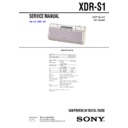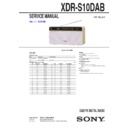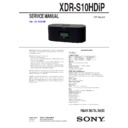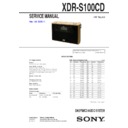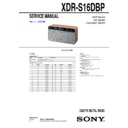Read Sony XDR-S1 Service Manual online
1
Ver 1.0 2004. 09
SERVICE MANUAL
AEP Model
UK Model
XDR-S1
SPECIFICATIONS
Time display
UK
12-hour system
Other countries/regions
24-hour system
Frequency range
Band
Band
Frequency
Channel step
DAB (L-Band)
1452.960
– 1490.624 MHz
DAB (Band-III)
174.928
– 239.200 MHz
FM
87.5 – 108 MHz
0.05 MHz
MW
531 – 1,602 kHz
9 kHz
LW
153 – 279 kHz
3 kHz
Speaker:
8 cm (3
1/4
inches) dia., 3.2
Ω
Power output:
2.3 W+2.3 W (at 10% harmonic distortion)
Output:
Headphone jack (stereo mini jack)
Power requirements:
230 V AC, 50 Hz
Power consumption:
13 W
Dimensions:
Approx. 320
× 142 × 154 mm (w/h/d)
(Approx. 12
3/4
× 5
5/8
× 6
1/8
inches) incl.
projecting parts and controls
Mass:
Approx. 2.5 kg (5 lb 8 oz)
Supplied accessories:
AC power cord (1),
Remote control (RMT-CS1AD) (1)
Remote control (RMT-CS1AD) (1)
Design and specifications are subject to change
without notice.
without notice.
Sony Corporation
Personal Audio Company
Published by Sony Engineering Corporation
9-879-193-01
2004I04-1
© 2004. 09
DAB/FM/MW/LW DIGITAL RADIO
2
XDR-S1
SAFETY-RELATED COMPONENT WARNING!!
COMPONENTS IDENTIFIED BY MARK
0
OR DOTTED LINE
WITH MARK
0
ON THE SCHEMATIC DIAGRAMS AND IN
THE PARTS LIST ARE CRITICAL TO SAFE OPERATION.
REPLACE THESE COMPONENTS WITH SONY PARTS WHOSE
PART NUMBERS APPEAR AS SHOWN IN THIS MANUAL OR
IN SUPPLEMENTS PUBLISHED BY SONY.
REPLACE THESE COMPONENTS WITH SONY PARTS WHOSE
PART NUMBERS APPEAR AS SHOWN IN THIS MANUAL OR
IN SUPPLEMENTS PUBLISHED BY SONY.
Flexible Circuit Board Repairing
• Keep the temperature of the soldering iron around 270˚C during
repairing.
• Do not touch the soldering iron on the same conductor of the
circuit board (within 3 times).
• Be careful not to apply force on the conductor when soldering
or unsoldering.
Notes on Chip Component Replacement
• Never reuse a disconnected chip component.
• Notice that the minus side of a tantalum capacitor may be dam-
• Notice that the minus side of a tantalum capacitor may be dam-
aged by heat.
•
UNLEADED SOLDER
Boards requiring use of unleaded solder are printed with the lead-
free mark (LF) indicating the solder contains no lead.
(Caution: Some printed circuit boards may not come printed with
the lead free mark due to their particular size.)
free mark (LF) indicating the solder contains no lead.
(Caution: Some printed circuit boards may not come printed with
the lead free mark due to their particular size.)
: LEAD FREE MARK
Unleaded solder has the following characteristics.
• Unleaded solder melts at a temperature about 40°C higher
• Unleaded solder melts at a temperature about 40°C higher
than ordinary solder.
Ordinary soldering irons can be used but the iron tip has to
be applied to the solder joint for a slightly longer time.
Soldering irons using a temperature regulator should be set
to about 350°C.
Caution: The printed pattern (copper foil) may peel away if
the heated tip is applied for too long, so be careful!
Ordinary soldering irons can be used but the iron tip has to
be applied to the solder joint for a slightly longer time.
Soldering irons using a temperature regulator should be set
to about 350°C.
Caution: The printed pattern (copper foil) may peel away if
the heated tip is applied for too long, so be careful!
• Strong viscosity
Unleaded solder is more viscous (sticky, less prone to flow)
than ordinary solder so use caution not to let solder bridges
occur such as on IC pins, etc.
than ordinary solder so use caution not to let solder bridges
occur such as on IC pins, etc.
• Usable with ordinary solder
It is best to use only unleaded solder but unleaded solder
may also be added to ordinary solder.
may also be added to ordinary solder.
TABLE OF CONTENTS
1. GENERAL
2. DISASSEMBLY
2-1. Cabinet (Rear) Assy ............................................................ 4
2-2. Wires ................................................................................... 5
2-3. Cabinet Upper Assy ............................................................ 5
2-4. Key Board ........................................................................... 6
2-5. Tuner Board ......................................................................... 6
2-6. Micon Board ....................................................................... 7
2-7. Power Board, Jack Board .................................................... 7
2-2. Wires ................................................................................... 5
2-3. Cabinet Upper Assy ............................................................ 5
2-4. Key Board ........................................................................... 6
2-5. Tuner Board ......................................................................... 6
2-6. Micon Board ....................................................................... 7
2-7. Power Board, Jack Board .................................................... 7
3. ELECTRICAL ADJUSTMENTS
................................... 8
4. DIAGRAMS
4-1. Printed Wiring Board –Tuner Section– ............................. 10
4-2. Printed Wiring Boards –Micon Section– .......................... 11
4-3. Schematic Diagram –Tuner, Micon Section– ................... 12
4-4. Printed Wiring Boards –Audio, Power Supply Section– .. 13
4-5. Schematic Diagram –Audio, Power Supply Section– ....... 14
4-2. Printed Wiring Boards –Micon Section– .......................... 11
4-3. Schematic Diagram –Tuner, Micon Section– ................... 12
4-4. Printed Wiring Boards –Audio, Power Supply Section– .. 13
4-5. Schematic Diagram –Audio, Power Supply Section– ....... 14
5. EXPLODED VIEWS
5-1. Cabinet (Rear) Section ...................................................... 17
5-2. Cabinet Front Section ........................................................ 18
5-3. Chassis Section ................................................................. 19
5-2. Cabinet Front Section ........................................................ 18
5-3. Chassis Section ................................................................. 19
6. ELECTRICAL PARTS LIST
........................................ 20
3
XDR-S1
SECTION 1
GENERAL
This section is extracted
from instruction manual.
from instruction manual.
• LOCATION OF CONTROLS
4
XDR-S1
• The equipment can be removed using the following procedure.
SECTION 2
DISASSEMBLY
2-1. CABINET (REAR) ASSY
Note : Follow the disassembly procedure in the numerical order given.
2-1.
CABINET (REAR) ASSY
(Page 4)
(Page 4)
2-2.
WIRES
(Page 5)
(Page 5)
SET
2-3.
CABINET UPPER ASSY
(Page 5)
(Page 5)
2-4.
KEY BOARD
(Page 6)
(Page 6)
2-5.
TUNER BOARD
(Page 6)
(Page 6)
2-6.
MICON BOARD
(Page 7)
(Page 7)
2-7.
POWER BOARD,
JACK BOARD
(Page 7)
JACK BOARD
(Page 7)
1
net assy
2
four screws
(+
(+
BV tapping (B3)
)
3
four screws
(+
(+
BV tapping (B3)
)
4
two screws
(+
(+
BV tapping (B3)
)
5
two screws
(+
(+
BV tapping (B3)
)
6
cabinet (rear) assy
four claws

